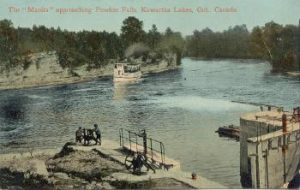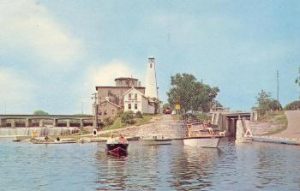Fenelon Falls is rich in native and pioneer history.
 More than 10,000 years ago Paleo-Indians inhabited the area. 2000 years ago came the Southern Woodland Indians, hunters who set up temporary camps in the area. In 1615 when Samuel de Champlain travelled what is now the Trent-Severn Waterway, Huron Indians had camps throughout the region. Unlike the previous tribes, the Hurons relied on both hunting and agriculture to survive.
More than 10,000 years ago Paleo-Indians inhabited the area. 2000 years ago came the Southern Woodland Indians, hunters who set up temporary camps in the area. In 1615 when Samuel de Champlain travelled what is now the Trent-Severn Waterway, Huron Indians had camps throughout the region. Unlike the previous tribes, the Hurons relied on both hunting and agriculture to survive.
Europeans began to arrive in this region around 1700. They were heavily engaged in the fur trade and it was not until the early 1800’s that the area around Fenelon Falls was settled. The first settlers hailed from the United Kingdom. The area of land that is now Fenelon Falls was originally called Cameron Falls after the first landowner, the Honourable Duncan Cameron, who was the provincial secretarary of Upper Canada between 1817 and 1838. When Cameron passed away in 1838, the land was sold to James Wallis and Robert Jameson who became the founders of the present village. Wallis’s home in the village, Maryboro Lodge still stands in it’s original location on Oak Street and is now the village museum.
Wallis and Jameson had dreams of setting up tenant farms. However this dream never became a reality. While Jameson returned to England, Wallis constructed the first mill in the township, a grist mill at the falls in 1841. Ten years later, he tore down this first mill and built a combination grist- and saw-mill in its place. Wallis entered the booming lumbering business and Fenelon Falls experienced great growth. When the mill burnt down eight years later, this growth was halted. The history of Fenelon Falls continues in this “boom and bust” manner. When the mills were up and running the town grew and prospered. However when the mills weren’t running, all expansion halted.
In 1874, the village of Fenelon Falls was incorporated. Then in 1876, the Victoria Railway reached Fenelon Falls. The village was booming. In 1885 construction of the a lock between Cameron and Sturgeon lake literally begin with a bang. The excavators were using a new explosive known as dynamite to blow rocks out of the prospective lock pits. They under-estmated this new blasting agent’s strength and sent chunks of limestone flying into the air and crashing through the roofs of buildings more than a hundred metres away. The waterway had reached Fenelon Falls.
When the lumber trade deteriorated the falls served another useful purpose.A Hydro-electric generating plant was built, and the falls produced enough power to supply Fenelon and Lindsay with electricity.
Since the turn of the century, tourism has been a large part of Fenelon Falls. The two lakes are home to many summer resorts, lodges and cottages. The friendly, laid-back atmosphere draws people for a relaxing holiday away from the husltle and bustle of home.
Lock 34 of the Trent Severn Waterway, in the heart of town, is one of the busiest locks on the waterway. People come to Fenelon Falls for their vacation, and return year after year.
The “Reader’s Digest” Version :
Once referred to as Cameron Falls, this village was named after Father Abbe Fenelon, a Sulpician Missionary who came to Canada in 1667. The Village of Fenelon Falls was incorporated in 1874 and by 1876 it had access to the Victoria Railway.
The village is located in Central Ontario, less than a two hour drive north-east from Toronto. In the year 2000, an amalgamation of Victoria County communities took place andFenelon Falls became a part of The City of Kawartha Lakes. Today Fenelon’s population is just over 2,000 residents.
 The “Encyclopedia Britanica” Version :
The “Encyclopedia Britanica” Version :
The area is very rich in native and pioneer history. More than 10,000 years ago Paleo-Indians inhabited the area. Two thousand years ago came the Southern Woodland Indians who set up temporary camps.
In 1615, explorer Samuel de Champlain travelled via the river system. Huron and Ojibway Indians inhabited the area. Actually ” Kawartha ” is an Ojibwa word meaning ” shining waters”.
The 1830’s was the main starting point for Irish and Scottish immigrants to settle into the area.
The Falls were the main economic reason people settled in Fenelon. The village grew over the years as mills, grocery stores, houses, churches and schools sprung up.
Since the turn of the century, tourism has been an important aspect of the community. Situated between two lakes, Cameron and Sturgeon, this area is home to many summer resorts, lodges and cottages.
Although hidden from plain view – as the town elders did not want to move the road which crosses over the river due to potential high costs – the Falls of Fenelon is indeed a spectacular sight viewed from paths built to the north and from nearby restaurants. The Falls themselves pour into a limestone gorge known to locals as the Fenelon River.
Over the years fishing has become a very popular sport in Fenelon Falls. The Trent-Severn Waterway System is another reason why tourists stop by. Lock 34, built in 1963 to replace two older locks, is 142 feet long and 35 feet wide. The lock boasts an 8 foot steel door at the top and 35 foot steel one at the bottom. It takes ten to fifteen minutes for boats to lock through. The Locks have become a popular tourist attraction over the years and are also lit up during the Christmas Season. Parks Canada is responsible for the maintenance and operation of the locks.
The village has been crowned with the title “ Jewel of the Kawarthas ”. The local Chamber of Commerce organizes a night-time Santa Claus Parade – which has existed since the 1930’s. The local Museum is found at the end of Oak Street in a beautiful squared-timber home built in 1873 by James Wallis.
As you walk the streets of Fenelon Falls circa 2008, you will find wonderful antique shops, a variety of restaurants & coffee houses, beautiful flower shops and trendy clothing boutiques. You will also experience lovely beaches, boating and snowmobiling. Most importantly you will encounter a friendly and laid back atmosphere !
As best described by one of our local residents :
“ The village grew ever-changing, but always remaining the same.
The years have been kind to Fenelon Falls and our village has a proud history. ”
